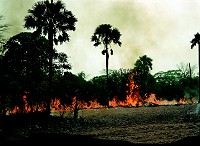Warm El Niños and cold La Niñas follow each other against the backdrop of the ocean seasons. Variable in intensity, these surface temperature and sea level anomalies in the intertropical Pacific cause major heat exchanges between the ocean and atmosphere, affecting climate worldwide.
| Drought over Indonesia and Papua New Guinea caused the destruction of 2.1 million hectares of trees, through forest fires. Total damage was estimated at $US 4.4 billion, with hundreds of casualties through famine and disease. |  |
 | With sea-surface temperature exceeding 28°C off the coast of Ecuador and northern Peru, rainfall in December 1997 and January 1998 reached 350 to 775 mm, 15 times the average. This resulted in flooding and landslides, and the destruction of roads, houses and crops. In Peru alone, the damage was estimated at $US 3.6 billion. Hundreds of people disappeared, cholera and malaria broke out. |
| Crop yields were destabilised around the world, with major impacts on national economies. Unusually warm weather in much of southern Africa led to the loss of 50% of the wheat crop, worth $US 130 million. With Côte d'Ivoire cocoa production due to fall by 15%, cocoa beans traded in August 1997 at $US 1900 a ton, the highest price since 1988. |  Credits Cane and al., 1994 |
 Credits Noaa | While anchovy fisheries were being disrupted across South America's western seaboard, sardine and tuna were thriving in the warmer waters off Santiago, Chile, producing a bumper year for fishermen. |
With storms shifting to the central Pacific, the Caribbean was calmer. And parts of North America and Japan enjoyed milder winters. |  Credits Nasa |





